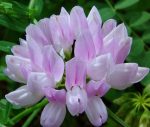 Also called purple vetch, this herbaceous perennial is native to Europe, southwest Asia, and northern Africa but was introduced to North America in the 1950s and was used as a green manure and to control soil erosion along roadsides and waterways and on embankments. Since then it has spread and naturalized in the northeastern US where it can be found in a variety of sites such as fields, grasslands, prairies, roadsides, waste areas and natural areas. Creeping stems of the plants quickly form large clumps that can cover and shade out native vegetation and the plant is considered invasive in Connecticut, Indiana, Kentucky, Maryland, Minnesota, Missouri, North Carolina, New Jersey, Oregon, Tennessee, Virginia, and Wisconsin. Plants spread by seeds and rhizomes that can be 10′ long.
Also called purple vetch, this herbaceous perennial is native to Europe, southwest Asia, and northern Africa but was introduced to North America in the 1950s and was used as a green manure and to control soil erosion along roadsides and waterways and on embankments. Since then it has spread and naturalized in the northeastern US where it can be found in a variety of sites such as fields, grasslands, prairies, roadsides, waste areas and natural areas. Creeping stems of the plants quickly form large clumps that can cover and shade out native vegetation and the plant is considered invasive in Connecticut, Indiana, Kentucky, Maryland, Minnesota, Missouri, North Carolina, New Jersey, Oregon, Tennessee, Virginia, and Wisconsin. Plants spread by seeds and rhizomes that can be 10′ long.
Crown vetch grows from a perennial crown and has long trailing branched stems that grow up to 6′ long forming a 2′ tall mass. The dark green compound leaves are 2-4″ long and consist of 11 to 25 pairs of leaflets that are 1/2 to 3/4″ long. From late spring to late summer umbels of 5-20 white, pink or purplish pea-like flowers appear that are 1/2″ wide and consist an upright standard and a lower keel. The fruit is a long slightly kidney shaped pod terminating is a long pointed beak and containing several long, smooth, brown seeds that are thought to be poisonous. Crown vetch prefers full sun and dry to moist soil in USDA Hardiness Zones 3-7. It is intolerant of flooded soil or shade .
The following natives are recommended alternatives:
Whorled Milkweed (Asclepias verticillata)
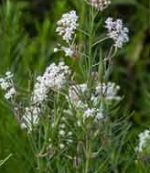 Also known as horsetail milkweed, this deep rooted herbaceous perennial is native to North America from Massachusetts and Saskatchewan south to Florida and Arizona where it grows in pastures, fields, prairies, meadows, open woods, and roadsides. Plants grow 1- 3′ tall and have unbranched stems carrying needle-like leaves 2-3″ long. The leaves have rolled margins and are arranged in whorls of 3 to 6 at the closely spaced nodes. They turn yellow at the end of the season and provide color to the fall garden. In mid to late summer, small, fragrant, greenish-white flowers appear in flat-topped clusters in the upper leaf axils. Each cluster is 3/4-1 3/4″ across and contains 3 to 20 flowers. The flowers are 1/4″ long and have 5 petals with hoods bearing incurved horns. Fruits are narrow pods up to 3″ long and contain silky-tailed seeds. USDA Hardiness Zones 4-9
Also known as horsetail milkweed, this deep rooted herbaceous perennial is native to North America from Massachusetts and Saskatchewan south to Florida and Arizona where it grows in pastures, fields, prairies, meadows, open woods, and roadsides. Plants grow 1- 3′ tall and have unbranched stems carrying needle-like leaves 2-3″ long. The leaves have rolled margins and are arranged in whorls of 3 to 6 at the closely spaced nodes. They turn yellow at the end of the season and provide color to the fall garden. In mid to late summer, small, fragrant, greenish-white flowers appear in flat-topped clusters in the upper leaf axils. Each cluster is 3/4-1 3/4″ across and contains 3 to 20 flowers. The flowers are 1/4″ long and have 5 petals with hoods bearing incurved horns. Fruits are narrow pods up to 3″ long and contain silky-tailed seeds. USDA Hardiness Zones 4-9
Spreading Dogbane (Apocynum androsaemifolium)
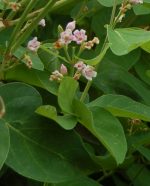 Also called fly-trap dogbane and bitterroot, this lanky herbaceous perennial is native to North America from Massachusetts and Saskatchewan, south to Florida and Arizona where it grows in prairies, meadows, open woods, woodland edges, thickets, and along roadsides. The plants grow up to 4′ tall from a rhizomatous root system and have widely branching stems that are light green to red and contain milk sap when broken. The spreading or drooping dark green leaves are .4 to 5 inches long and oval with pointed tips. In autumn the foliage turns yellow, orange, or rose. During the summer terminal cymes 1-4″ wide appear and consist of slightly nodding flowers that are bell-shaped and fragrant. Each flower is 1/4″ wide and has 5 recurved petals that are white striped with pink. USDA Hardiness Zones 4-8
Also called fly-trap dogbane and bitterroot, this lanky herbaceous perennial is native to North America from Massachusetts and Saskatchewan, south to Florida and Arizona where it grows in prairies, meadows, open woods, woodland edges, thickets, and along roadsides. The plants grow up to 4′ tall from a rhizomatous root system and have widely branching stems that are light green to red and contain milk sap when broken. The spreading or drooping dark green leaves are .4 to 5 inches long and oval with pointed tips. In autumn the foliage turns yellow, orange, or rose. During the summer terminal cymes 1-4″ wide appear and consist of slightly nodding flowers that are bell-shaped and fragrant. Each flower is 1/4″ wide and has 5 recurved petals that are white striped with pink. USDA Hardiness Zones 4-8
Bearberry (Arctostahylos uva-ursi)
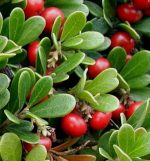 Bearberry is a fine textured evergreen ground cover that is native to northern parts of Europe, Asia and North America. In North America it can be found growing on dunes, outcroppings, lakeshores, and open woods from Labrador and British Columbia, south to Virginia, New Mexico and California. The leaves are simple and dark green, sometimes taking on a bronze or reddish tinge by fall. The plants reach grow up to 12” tall and slowly form dense attractive mats. In spring, bearberry features tiny, dropping, bell-shaped white to pink flowers that are followed by bright red berries in late summer. USDA Hardiness Zones 2-7
Bearberry is a fine textured evergreen ground cover that is native to northern parts of Europe, Asia and North America. In North America it can be found growing on dunes, outcroppings, lakeshores, and open woods from Labrador and British Columbia, south to Virginia, New Mexico and California. The leaves are simple and dark green, sometimes taking on a bronze or reddish tinge by fall. The plants reach grow up to 12” tall and slowly form dense attractive mats. In spring, bearberry features tiny, dropping, bell-shaped white to pink flowers that are followed by bright red berries in late summer. USDA Hardiness Zones 2-7
Virginia Creeper (Parthenocissus quinquefolia)
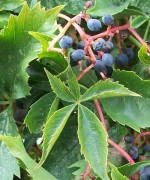 This woody deciduous vine grows thirty to fifty feet long and has palmate leaves with five leaflets that turn bright red to burgundy in fall while indigo berries appear on cerise stalks. It is native to woodland borders, clearings, meadows, and roadside from Quebec, Manitoba and Utah, south to Florida and Texas. USDA Hardiness Zones 3-9
This woody deciduous vine grows thirty to fifty feet long and has palmate leaves with five leaflets that turn bright red to burgundy in fall while indigo berries appear on cerise stalks. It is native to woodland borders, clearings, meadows, and roadside from Quebec, Manitoba and Utah, south to Florida and Texas. USDA Hardiness Zones 3-9
American Vetch (Vicia americana)
 Also known as purple vetch, American deer vetch, and stiff-leaf vetch, this perennial vine is native to North America from Alaska to Ontario and New York, south to Virginia, Kentucky and Arizona and can be found growing in a variety of habitats from swampy woods and mixed forests to chaparral and badlands. Plants have a deeply branched taproot up to 40″ long, rhizomes, and a climbing stem that grows up to 4′ tall. The pinnately compound leaves have 8 to 18 oblong leaflets up to 1.5″ long and have tendrils for climbing. In summer up to 10 purple flowers appear in racemes. Each pea-like flower is up to 1.5″ long and has a backwards curving banner petal and four smaller inner petals. The fruit is a flat pod 1-1.5″ long and bears two to several seeds. American vetch is valuable source of food for both domestic and wild animals. In addition, it is especially valuable as a cover crop because it adds nitrogen to the soil, and can be useful in restoration projects. USDA Hardiness Zones 4-8
Also known as purple vetch, American deer vetch, and stiff-leaf vetch, this perennial vine is native to North America from Alaska to Ontario and New York, south to Virginia, Kentucky and Arizona and can be found growing in a variety of habitats from swampy woods and mixed forests to chaparral and badlands. Plants have a deeply branched taproot up to 40″ long, rhizomes, and a climbing stem that grows up to 4′ tall. The pinnately compound leaves have 8 to 18 oblong leaflets up to 1.5″ long and have tendrils for climbing. In summer up to 10 purple flowers appear in racemes. Each pea-like flower is up to 1.5″ long and has a backwards curving banner petal and four smaller inner petals. The fruit is a flat pod 1-1.5″ long and bears two to several seeds. American vetch is valuable source of food for both domestic and wild animals. In addition, it is especially valuable as a cover crop because it adds nitrogen to the soil, and can be useful in restoration projects. USDA Hardiness Zones 4-8
Purple Prairie Clover (Dalea purpurea)
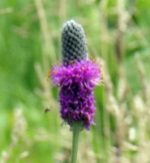 Purple prairie clover is a herbaceous perennial native to central North America from Ontario to Georgia west to Alberta and Arizona where it grows in prairies, savannas, and open woods. Plants grow 1-3″ tall and have multiple stems and pinnately compound dark green leaves with 3-7 narrow leaflets about 1″ long. The small purple flowers are produced on 1-2” cone-like spikes and are accented by golden anthers that extend beyond the petals. The flowers begin to open at the bottom of the cone and form a wreath that gradually moves upward resulting in a long bloom period that extends from mid-summer into fall. USDA Hardiness Zones 3-8
Purple prairie clover is a herbaceous perennial native to central North America from Ontario to Georgia west to Alberta and Arizona where it grows in prairies, savannas, and open woods. Plants grow 1-3″ tall and have multiple stems and pinnately compound dark green leaves with 3-7 narrow leaflets about 1″ long. The small purple flowers are produced on 1-2” cone-like spikes and are accented by golden anthers that extend beyond the petals. The flowers begin to open at the bottom of the cone and form a wreath that gradually moves upward resulting in a long bloom period that extends from mid-summer into fall. USDA Hardiness Zones 3-8
Eastern Braken Fern (Pteridium aquilinum)
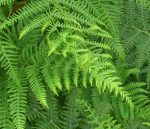 Also known as eagle fern, braken is a herbaceous perennial native to most of North America where it grows in a variety of habitats including open woodlands, meadows, savannas, thickets, marshes,burned areas and roadsides. The plants grow 3-4′ tall and consist of a rhizomatous root system that sends up coarse triangular fronds that are 2-3 times pinnately compound. The fronds are yellowish green to green and those of plants grown in the shade may be almost horizontal. USDA Hardiness Zones 3-1
Also known as eagle fern, braken is a herbaceous perennial native to most of North America where it grows in a variety of habitats including open woodlands, meadows, savannas, thickets, marshes,burned areas and roadsides. The plants grow 3-4′ tall and consist of a rhizomatous root system that sends up coarse triangular fronds that are 2-3 times pinnately compound. The fronds are yellowish green to green and those of plants grown in the shade may be almost horizontal. USDA Hardiness Zones 3-1